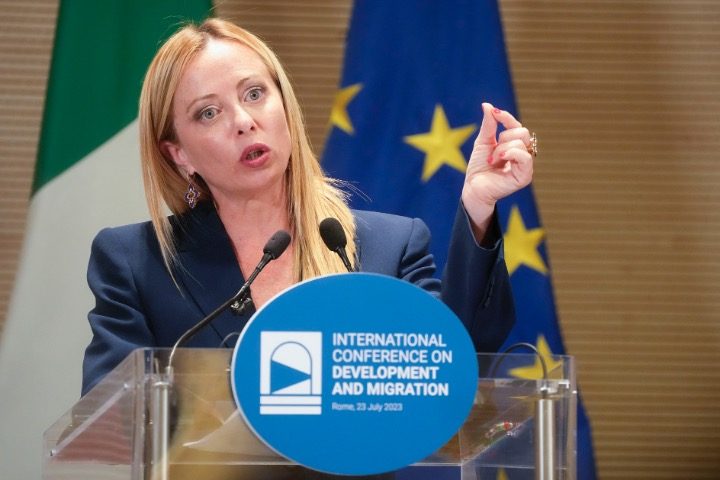
Last month, right-wing Italian Prime Minister Giorgia Meloni revealed that she would be granting 452,000 work visas for non-EU nationals from 2023 to 2025. This is a sharp increase compared to the 30,850 permits that were issued in 2019. The Meloni government cites labor shortages in several industries due to an aging and declining population.
Meloni recently met with more than 20 countries from the Mediterranean, Middle East, and Africa to tackle illegal immigration and confront some of the reasons migrants flee their home nations to reach Europe. The one-day conference took place in Rome and sought to foster relationships with Mediterranean countries in order to manage the flow of illegal immigrants landing on Italy’s shores. In 2023, over 83,000 illegal immigrants arrived in Italy, compared to around 34,000 in 2022.
Meloni proposed four main prongs for future cooperation: fighting criminal organizations trafficking migrants, better managing flows of migrants, supporting refugees, and helping countries of origin. In Meloni’s opening statement, she stated, “The West too often has given the impression of being more interested in giving lessons rather than lending a hand. It is probably this difference that has made it difficult to make progress on solutions.”
To help improve the conditions of the countries immigrants are fleeing, participants from the more than 20 countries agreed to make funding available for development projects in what Meloni stated would be a “Rome Process.” The United Arab Emirates pledged €100 million to help improve conditions in countries where poverty pushes emigration. In her opening remarks, Meloni stated, “In an era where so much attention is given to the right to migrate, we are not paying sufficient attention to the right to not be forced to emigrate, to not be forced to flee their own homes, to not be forced to abandon their land and leave family members in search of a new life.”
Meloni also mentioned that if illegal immigration were better managed, then there would be more room for legal migration. She stated that since quotas are filled by illegal migration, there are no legal means of entry for those seeking refugee status. The prime minister admitted that she was open to creating legal and safe routes for migration, stating that “Europe and Italy needed immigration.”
Luigi Scazzieri, a senior research fellow at the Centre for European Reform, stated that “Meloni has changed tone on legal migration, aware of labour shortages in Italy. But she has not changed tone on illegal migration.” He went on to state, “I think her shift also reflects a recognition that she needs to offer third countries some legal migration routes if she wants them to co-operate more in terms of reducing illegal migration flows.”
The labor shortages in Italy are partially due to a dying population, as the nation has been experiencing a decline in births every year since 2008. Italy had an average of 1.25 babies per woman for 2022, well below the replacement number of 2.1 births per woman. In fact, according to the Italian National Institute of Statistics (ISTAT), the country had just 393,000 births in 2022, with 12 deaths for every 7 births, the lowest since records began in 1861.
The economic consequences of Italy’s low birth rate are disastrous, as the pay-as-you-go pension system in place relies on current workers to pay for the retired population’s pension benefits. By 2044, pension spending is projected to reach its peak, as the large baby boomer generation will put immense stress on the small, working population. At least 500,000 births are needed annually to prevent Italy’s social security system from collapsing. The Italian economy minister warned that the country’s GDP could drop by 18 percent over the next 20 years if the low birth rate is not reversed.
In order to increase the birth rate, the Italian government has put into place incentives such as monthly payments of up to €175 per child. The policy was put in place in May of 2021 and continued under Meloni. The current government has proposed new measures to encourage a rise in births, such as lowering taxes for households with kids, helping young couples to buy their first homes, and urging communities to provide free daycare.
In response to Italy’s low birth rates in 2022 and the increase in illegal immigrants, a close political ally and brother-in-law of Meloni, Francesco Lollobrigida, stated that “the way is to build a welfare system that allows you to work and have a family, supporting young couples to find employment. Italians are having fewer children, so we’re replacing them with someone else. Yes to helping births, no to ethnic replacement. That’s not the way forward.” The head of Italy’s Democratic Party, Elly Schlein, labeled his statement “disgusting” and “reminiscent of the fascist regime of Benito Mussolini.”
The disastrous low birth rate is not limited to Italy, as the rest of Europe also faces total fertility rates well below replacement level. In fact, in 2023 the European average was 1.5 births per woman. Those with the highest fertility rates on the Continent include France, Ireland, Romania, Denmark, and Iceland. Italy, Spain, and Ukraine are among those with the lowest fertility rates, with an average of only 1.3 children per woman.
As birth rates remain low across Europe, many countries have turned to immigration to resolve labor shortages and keep up their GDPs. However, while migration may be a quick and easy fix for a decreasing population, the long-term demographic effects of importing millions of foreigners will be disastrous on the culture and identity of the European nations.



